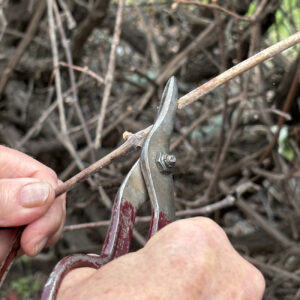
Root Pressure and the Flow of Sap
Director Lew Feldman
A Garden member recently wrote me seeking an explanation for the liquid (sap) dripping from the cut ends of her newly pruned ‘Roger’s Red’ grapevines. The dripping had continued for over a week and she wondered about the cause, and whether the loss of sap would be harmful for her grape.
The usual cause for this type of excessive dripping of sap is pruning too late in the winter/spring season. Now, let’s explore this explanation.
Grapevines are deciduous–they lose their leaves at the end of the growing season. As the leaves prepare to fall, they export any remaining nutrients, including sugars, to the root system. These sugars are stored as starch in the roots through the winter.
As spring approaches and the soil warms, starch is converted back to sugars, and water flows from the area of lower sugar concentration (the soil) into the area of higher sugar concentration (the roots) by the process of osmosis. As water moves into the roots it builds up pressure, aptly named “root pressure,” forcing the water and its dissolved materials (the sap) to move upwards through a series of tube-like vessels known as xylem. This sap carries the dissolved sugars, minerals, and more, that nurture the growing shoot tips, where new leaves and flowers will form. This is the main physiological function of root pressure, which was apparently first measured in grapevines by the English clergyman Stephen Hales in 1727. (One of Hales’ many contributions to science also includes the first measurements of blood pressure.)

Pruning grapevines too late in the winter/spring season, as root pressure is causing the sap to rise, interrupts sap flow by opening the water conducting xylem tubes directly to the outside environment: liquid then drips from the opened (pruned) ends. Excessive sap loss as a result of late pruning can indeed be harmful to the plant since nutrients destined to supply the newly growing shoot tips are now being lost to the external environment.
